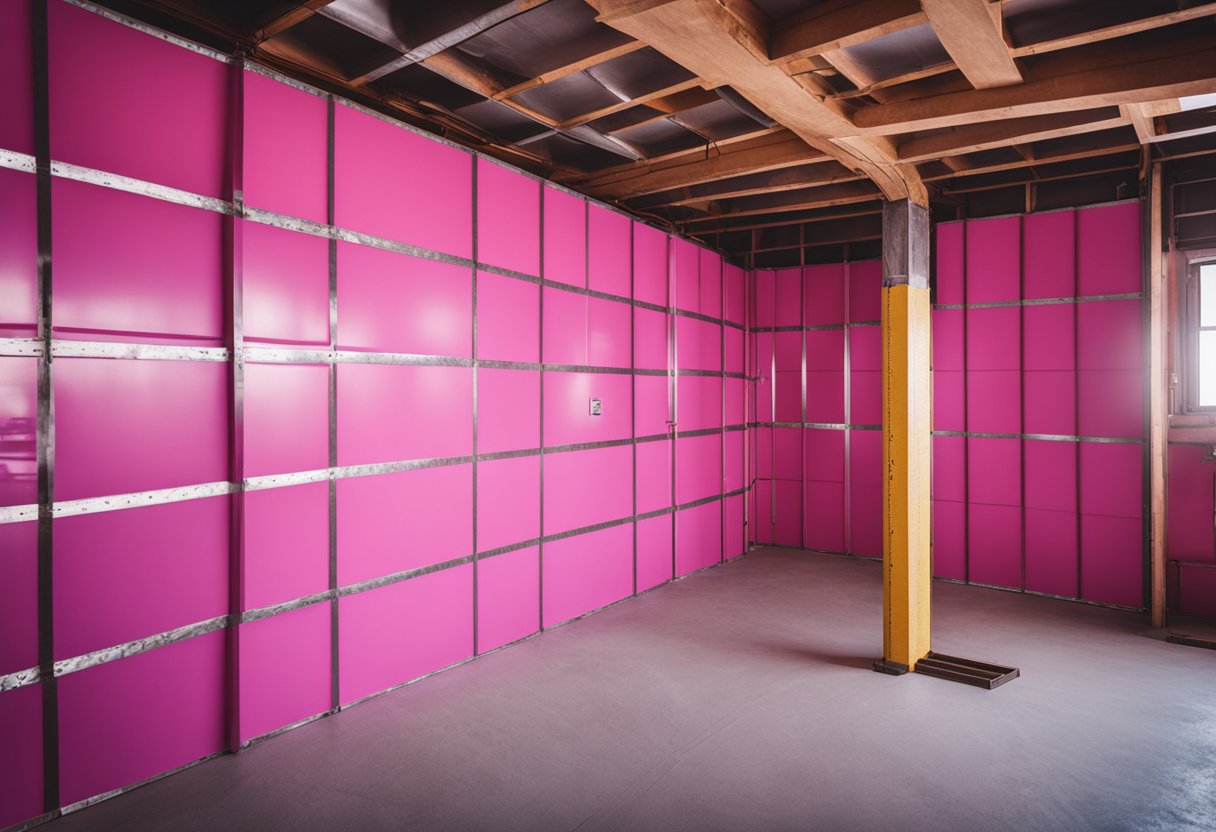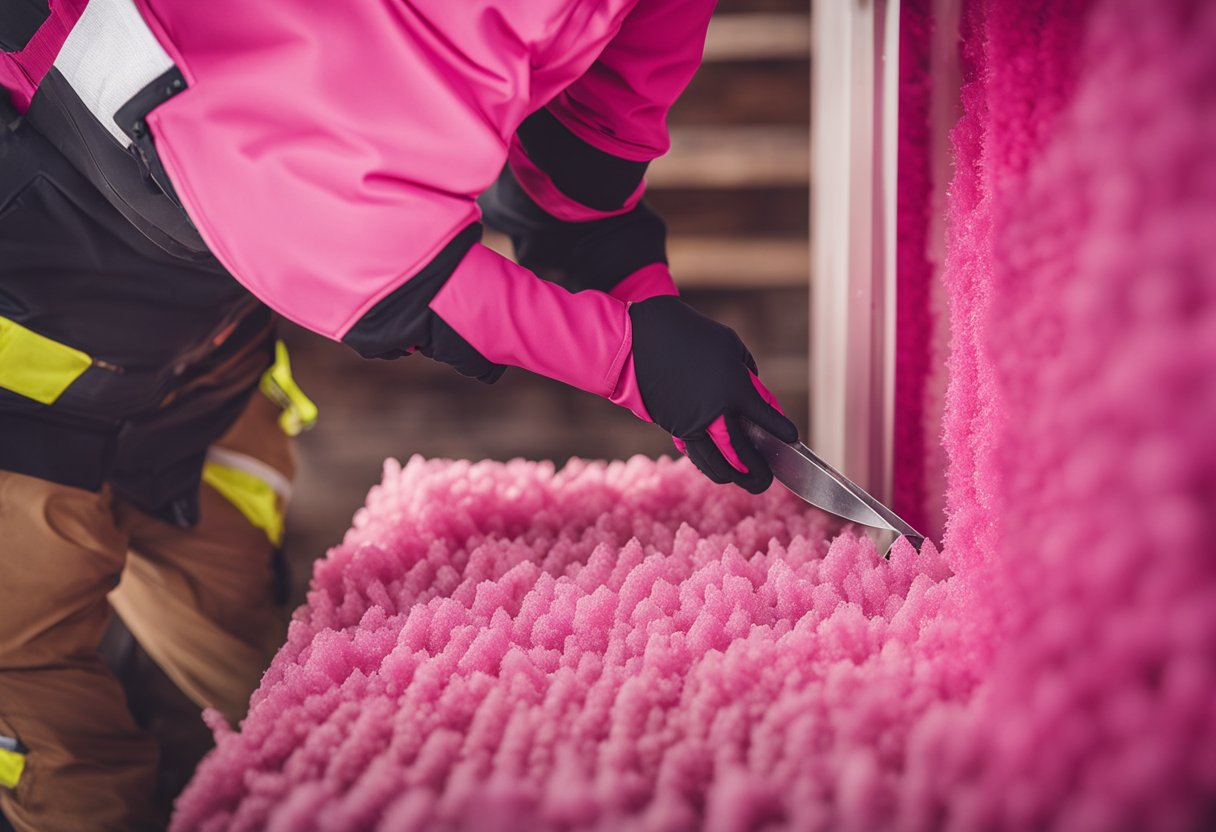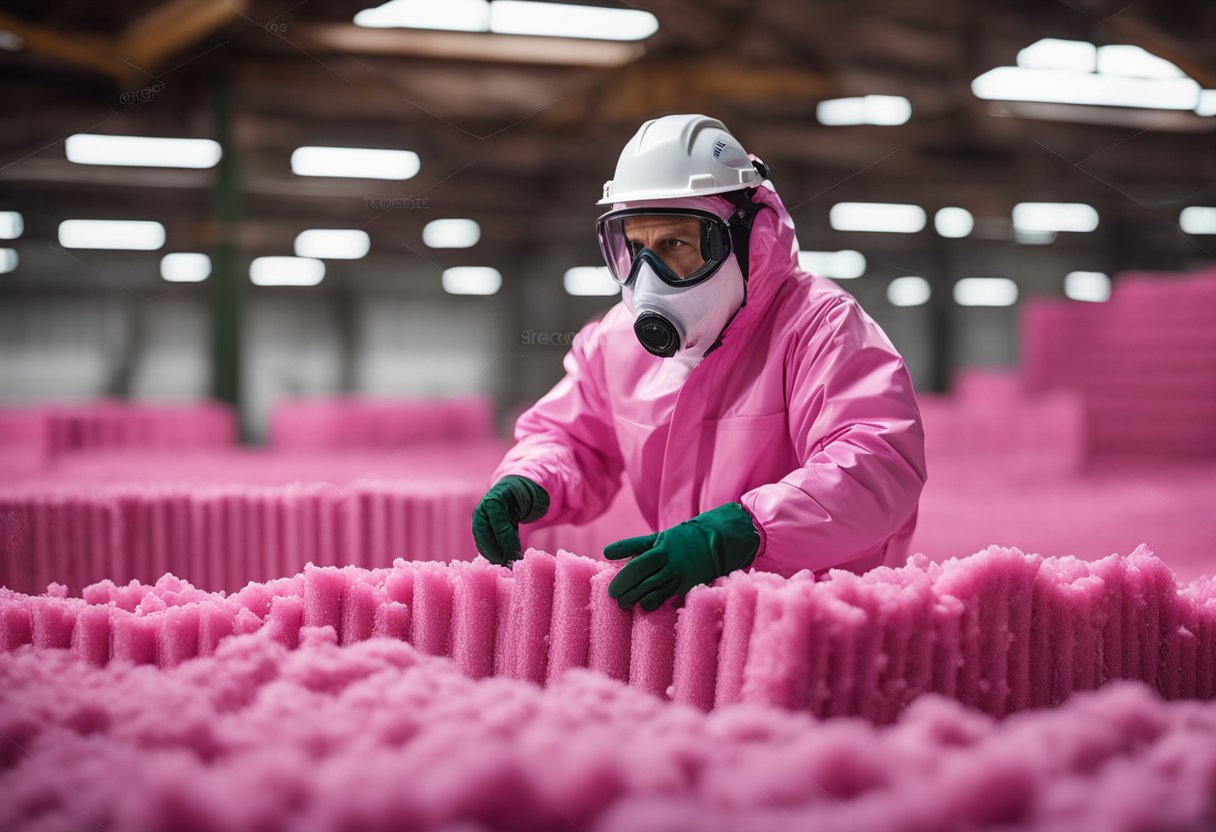I have researched the topic of whether exposed pink insulation is dangerous and have found several factors to consider. First, it’s important to understand what insulation is and how it works. Insulation is typically used to regulate temperature and reduce noise levels in homes and buildings. The most common type of insulation in the United States is fiberglass insulation, which is typically pink in color.

While insulation is generally safe and effective when properly installed, exposed insulation can pose potential health risks. According to a source from IBP Insulation Contractors, leaving insulation exposed is often an intentional tactic used by builders, but it can be dangerous if it’s in the wrong place. Exposed insulation in the basement or other occupied areas can cause skin allergies, eye irritation, and respiratory problems. Additionally, exposed insulation is recognized as a fire hazard and can increase the risk of fire in a building.
Key Takeaways
- Exposed pink insulation can pose potential health risks and is recognized as a fire hazard.
- Proper installation of insulation is crucial to its safety and effectiveness.
- Seeking professional assistance and taking precautions can help ensure safe handling and installation of insulation.
Understanding Insulation

As a homeowner, it is important to understand the basics of insulation and the potential risks involved with exposed insulation. Insulation is a material that is used to reduce heat transfer between two areas with different temperatures. It is typically installed in the walls, floors, and ceilings of a home to keep it warm in the winter and cool in the summer.
Fiberglass insulation is a common type of insulation material that is made from fine glass fibers. It comes in batts or rolls and is typically pink in color. Fiberglass insulation is a popular choice because it is affordable, easy to install, and has a high R-value, which is a measure of its thermal resistance.
While fiberglass insulation is generally safe to use, it can be dangerous if it becomes exposed. Exposed fiberglass insulation can release tiny, needle-like fibers into the air, which can be inhaled and cause health issues such as skin irritation and respiratory problems.
It is important to note that not all types of insulation pose the same risks. For example, spray foam insulation and rigid foam insulation are less likely to release fibers into the air because they are applied as a liquid or solid and do not break down over time. Cellulose insulation and cotton insulation are also less likely to release fibers because they are made from natural materials.
When it comes to insulation, it is important to choose the right type for your home and to ensure that it is installed properly. If you have exposed insulation in your home, it is important to take the necessary precautions to protect yourself and your family.
Potential Health Risks
As a professional insulation contractor, I have seen many cases where exposed pink insulation can pose potential health risks to homeowners. In this section, I will discuss the most common health hazards associated with exposed pink insulation, including respiratory concerns, skin and eye irritation, carcinogenic risks, and other health issues.
Respiratory Concerns
Fiberglass insulation, the primary component of pink insulation, can cause respiratory problems if its particles are inhaled. According to IBP Insulation Contractors, fiberglass insulation can cause lung irritation and asthma-like symptoms, such as coughing and wheezing. Long-term exposure to fiberglass insulation can lead to more severe respiratory problems, such as bronchitis.
Skin and Eye Irritation
Exposure to fiberglass insulation can also cause skin and eye irritation. Tiny glass particles can get embedded in the skin, causing itching and rashes. In severe cases, fiberglass insulation can cause eye irritation and even blindness if the particles get into the eyes. According to Homelogic, fiberglass insulation absorbs moisture, which can lead to the growth of mold and mildew, further exacerbating skin and eye irritation.
Carcinogenic Risks
The tiny, needle-like fibers in fiberglass insulation can become airborne when the insulation is disturbed, such as during installation or removal. Inhalation of these fibers can lead to health issues, including cancer. According to Angi, fiberglass insulation is not classified as a carcinogen, but the International Agency for Research on Cancer (IARC) has classified glass wool, the raw material used to make fiberglass insulation, as possibly carcinogenic to humans.
Other Health Issues
In addition to respiratory concerns, skin and eye irritation, and carcinogenic risks, exposure to fiberglass insulation can also cause pain and other health issues. According to Attainable Home, fiberglass insulation can cause irritation and pain in the throat, nose, and eyes. Long-term exposure to fiberglass insulation can also lead to severe long-term effects on the respiratory system, such as asbestosis and mesothelioma.
In conclusion, exposed pink insulation can pose significant health risks to homeowners. It is essential to take necessary precautions when handling or removing fiberglass insulation to prevent respiratory concerns, skin and eye irritation, carcinogenic risks, and other health issues.
Environmental Considerations

As a homeowner, it’s important to consider the environmental impact of your home insulation. The Environmental Protection Agency (EPA) recommends using insulation with recycled content and avoiding insulation made with formaldehyde, a known carcinogen.
Pink fiberglass insulation, which is the most common type of insulation used in homes, is made from glass fibers and is generally considered safe for the environment. However, it’s important to note that fiberglass insulation can release small particles into the air if it becomes damaged or disturbed. These particles can be harmful to breathe in and can cause irritation to the skin and eyes.
In addition to potential health concerns, moisture and mildew can also be a problem with exposed insulation. Moisture can cause the insulation to lose its effectiveness, and can also lead to the growth of mold and mildew. This can be a particular concern for those with allergies or respiratory issues.
Toxins can also be a concern when it comes to insulation. Some insulation materials contain harmful chemicals that can release into the air over time. It’s important to choose an insulation material that is free from harmful chemicals and is safe for you and your family.
Finally, it’s worth considering the water and energy efficiency of your insulation. Properly installed insulation can help to reduce your energy bills and make your home more energy-efficient. It can also help to reduce your water usage by preventing moisture buildup and mold growth.
Overall, it’s important to choose an insulation material that is safe for you and the environment. Pink fiberglass insulation is generally considered safe, but it’s important to take precautions to avoid exposure to small particles. By choosing an insulation material that is free from harmful chemicals and is energy and water-efficient, you can help to protect your home and the environment.
Fire Hazards and Precautions

As a professional insulation contractor, I have seen many cases where exposed pink insulation has posed a fire hazard. While pink insulation is made of fiberglass that is naturally flame-resistant, it is not completely fireproof. If exposed to high temperatures, it can ignite and spread fire quickly.
To prevent fire hazards, it is important to seal all exposed insulation properly. This can be done using a variety of methods, such as covering it with drywall or using a spray foam insulation. It is also important to avoid using any flammable materials near the insulation.
In addition, adding flame retardants to the insulation can help reduce the risk of fire. These chemicals can slow down or prevent the spread of fire, giving you more time to evacuate the building in case of an emergency. However, it is important to note that not all flame retardants are created equal. Some, such as HBC and halogenated flame retardants, have been linked to health and environmental concerns.
Therefore, it is important to choose flame retardants that are safe and effective. Look for products that have been tested and certified by independent organizations, such as UL or GreenGuard. These products have been shown to meet strict safety and environmental standards, giving you peace of mind that your insulation is both safe and effective.
Overall, while pink insulation can be a fire hazard if not properly sealed and protected, taking the necessary precautions can greatly reduce this risk. By sealing the insulation, avoiding flammable materials, and using safe and effective flame retardants, you can ensure that your home or building is both comfortable and safe.
Safe Handling and Installation

As a professional insulation installer, I understand the importance of taking proper precautions when handling exposed pink insulation. In this section, I will discuss some basic guidelines for safe handling and installation of fiberglass insulation.
Protective Clothing and Gear
When working with any type of insulation, it is essential to wear protective clothing and gear to prevent skin irritation and inhalation of fibers. I always wear gloves, long-sleeved shirts, and pants to avoid direct contact with the insulation. A dust mask is also necessary to prevent inhalation of fiberglass particles.
Proper Installation Techniques
Proper installation techniques are essential to ensure that the insulation is installed correctly and safely. Builders and construction professionals should follow manufacturer instructions and guidelines for paneling, drywall, flooring, sheetrock, plaster, brick, cork, polyurethane spray foam insulation, blown-in, and rigid boards.
It is important to note that exposed insulation can pose a health risk if not installed correctly. For example, if the insulation is not properly cut and fitted, it can create gaps that allow air to flow through, reducing its effectiveness and potentially causing health problems due to the release of fiberglass particles.
In conclusion, taking proper precautions and following manufacturer guidelines for installation is essential when working with exposed pink insulation. By following these guidelines, builders and construction professionals can ensure that the insulation is installed correctly and safely, minimizing the risk of health problems and maximizing its effectiveness.
Professional Assistance

If you have exposed pink insulation in your home, it is important to seek professional assistance to determine if it is a health hazard. Experts in insulation can assess the condition of the insulation and recommend the appropriate steps to take.
One of the first steps in seeking professional assistance is to schedule an appointment with a reputable insulation contractor. During the appointment, the contractor will inspect the insulation and determine if it needs to be removed or replaced. They will also provide advice on how to properly handle the insulation during renovation or removal.
It is important to note that not all exposed insulation is dangerous. However, it is recommended to err on the side of caution and seek professional assistance to ensure that your home is safe. A professional can provide you with the necessary information to make an informed decision about your insulation.
When looking for a professional insulation contractor, it is important to find someone who is knowledgeable and experienced. Look for someone who has a good reputation and positive reviews from previous customers. You can also check with your local Better Business Bureau to see if there are any complaints against the contractor.
In summary, seeking professional assistance from an experienced insulation contractor is the best way to ensure that your exposed pink insulation is not a health hazard. They can provide you with the necessary information and recommendations to keep you and your family safe during renovation or removal.
Frequently Asked Questions

Is exposed fiberglass insulation dangerous?
Yes, exposed fiberglass insulation can be dangerous. The tiny, needle-like fibers in fiberglass insulation can become airborne and inhaled, which can lead to health issues, including cancer. It is important to take necessary precautions when working with or around exposed fiberglass insulation.
Can covering fiberglass insulation with plastic reduce its danger?
Covering fiberglass insulation with plastic can help reduce its danger by preventing the tiny fibers from becoming airborne. However, it is important to note that covering fiberglass insulation with plastic is not a permanent solution and the insulation should be properly enclosed or removed as soon as possible.
Is insulation safe to touch?
Insulation is generally safe to touch, but it is important to wear protective clothing and gloves when handling insulation to prevent skin irritation or exposure to harmful chemicals.
Is it safe to breathe in fiberglass insulation?
No, it is not safe to breathe in fiberglass insulation. Inhaling fiberglass particles can lead to health issues, including cancer. It is important to wear a mask and take necessary precautions when working with or around fiberglass insulation.
Is it safe to be in a room with exposed insulation?
Exposure to exposed insulation can be dangerous, especially if the insulation is made of fiberglass. It is important to take necessary precautions, such as wearing protective clothing and gloves, and properly enclosing or removing the insulation as soon as possible.
Should you wear a mask when handling fiberglass insulation?
Yes, it is important to wear a mask when handling fiberglass insulation to prevent inhaling the tiny particles that can lead to health issues, including cancer. It is also important to wear protective clothing and gloves to prevent skin irritation or exposure to harmful chemicals.

Hi, I’m Sal Muller of Tooltrip.com. My DIY experience led me to understand essential power tools for home projects. Tooltrip.com guides enthusiasts and professionals in choosing right tools for any job. I provide concise top tool reviews for easier, efficient DIY.

